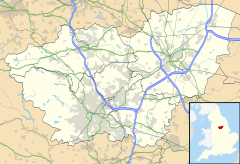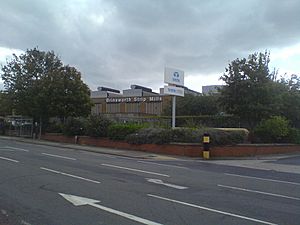Templeborough facts for kids
Quick facts for kids Templeborough |
|
|---|---|
| OS grid reference | SK410916 |
| Metropolitan borough |
|
| Metropolitan county | |
| Region | |
| Country | England |
| Sovereign state | United Kingdom |
| Post town | ROTHERHAM |
| Postcode district | S60 |
| Dialling code | 01709 |
| Police | South Yorkshire |
| Fire | South Yorkshire |
| Ambulance | Yorkshire |
| EU Parliament | Yorkshire and the Humber |
| UK Parliament |
|
Templeborough is a place in Rotherham, South Yorkshire, England. It's a part of the Brinsworth and Catcliffe area. Templeborough got its name from an old Roman fort found there. People used to think it was a Roman temple, but it was actually a fort.
Contents
The Roman Fort at Templeborough
A Roman fort was first built here a very long time ago, between the years 43 and 68 AD. It was first made from earth and wood. Later, the Romans rebuilt it using strong stone. People think the fort was used until the Romans left Britain around 410 AD. We don't know the fort's original name.
An old Roman road called Icknield Street crossed the River Don near the fort. There was also another road, Batham Gate, that went southwest from the fort to a signal station called Navio in Derbyshire. Even in 1831, you could still see the double banks around the fort. However, people often took stones from the fort to use in other buildings nearby.
Digging Up the Past: Archaeological Finds
In 1877, people from the Rotherham Literary and Scientific Society started digging at the fort. They found parts of the fort and a bath house. They discovered that the fort had been burned down and rebuilt two times. They also found old Roman coins from the time of emperors like Augustus and Constantine I.
In 1916, a steel company called Steel, Peech and Tozer bought the land where the fort was. They wanted to make their factory bigger for World War I. To do this, they had to flatten the area, which meant removing a lot of soil. This destroyed many of the old Roman remains.
But before the factory was built, an expert in Roman history, Sir Thomas May, was asked to dig up the fort again. He worked for eight months, from November 1916 to July 1917.
Who Lived at the Fort?
During the digs, a clay tile was found with a special stamp. This stamp showed that the Fourth Cohort of Gauls lived at the fort. This group of Roman soldiers was from Gaul (modern-day France). They also found clay tiles and carved Roman tombstones. These tombstones give us clues about the people who lived and died there. One of the tombstones is one of the earliest known memorials to a named British woman.
Some important finds included:
- A tombstone for a soldier named Cintusmus. It says he was a soldier of the Fourth Cohort of Gauls.
- A tombstone for a veteran (an experienced soldier) named Crotus Vindex. It says he was 40 years old and that his wife, Flavia Peregrina, made the monument for him.
- A tombstone for a woman named Verecunda Rufilia. She was from the Dobunni tribe and was 35 years old. Her husband, Excingus, placed the stone for his "dearest wife."
Today, you can see these amazing finds at the Clifton Park Museum in Rotherham. The original stone columns from the Roman granary (where they stored grain) at Templeborough Fort were put back up in Clifton Park in 1922.
Templeborough Steelworks
Steel, Peech and Tozer, also known as "Steelos," was a very large steel factory in Rotherham. In 1918, they joined with other steel companies to form United Steel Companies (USC). The Templeborough steelworks was huge, said to be a mile long! At its busiest time in the mid-1900s, about 10,000 people worked there.
In the 1950s, the old furnaces at Templeborough were becoming outdated. So, USC started a big project called "Operation SPEAR." They brought in six new electric furnaces to replace the 14 old ones. This made the Templeborough factory the biggest electric steel-making plant in the world. It could make 1.8 million tons of steel every year!
The steelworks became part of the British Steel Corporation in 1967. The factory finally closed in 1993. Part of the old steelworks has now been turned into a fun museum called the Magna Centre. It cost £46 million to build! The only part of the original Steel, Peech and Tozer plant that is still making steel today is the Brinsworth Strip Mills.
See also
 In Spanish: Templeborough para niños
In Spanish: Templeborough para niños




